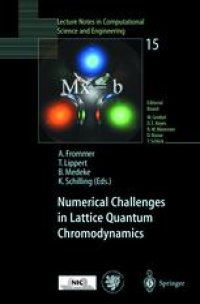
Ebook: Numerical Challenges in Lattice Quantum Chromodynamics: Joint Interdisciplinary Workshop of John von Neumann Institute for Computing, Jülich, and Institute of Applied Computer Science, Wuppertal University, August 1999
Author: Herbert Neuberger (auth.) Andreas Frommer Thomas Lippert Björn Medeke Klaus Schilling (eds.)
- Tags: Numerical Analysis, Theoretical Mathematical and Computational Physics, Algorithms
- Series: Lecture Notes in Computational Science and Engineering 15
- Year: 2000
- Publisher: Springer-Verlag Berlin Heidelberg
- Edition: 1
- Language: English
- pdf
Lattice gauge theory is a fairly young research area in Theoretical Particle Physics. It is of great promise as it offers the framework for an ab-initio treatment of the nonperturbative features of strong interactions. Ever since its adolescence the simulation of quantum chromodynamics has attracted the interest of numerical analysts and there is growing interdisciplinary engage ment between theoretical physicists and applied mathematicians to meet the grand challenges of this approach. This volume contains contributions of the interdisciplinary workshop "Nu merical Challenges in Lattice Quantum Chromo dynamics" that the Institute of Applied Computer Science (IAI) at Wuppertal University together with the Von-Neumann-Institute-for-Computing (NIC) organized in August 1999. The purpose of the workshop was to offer a platform for the exchange of key ideas between lattice QCD and numerical analysis communities. In this spirit leading experts from both fields have put emphasis to transcend the barriers between the disciplines. The meetings was focused on the following numerical bottleneck problems: A standard topic from the infancy of lattice QCD is the computation of Green's functions, the inverse of the Dirac operator. One has to solve huge sparse linear systems in the limit of small quark masses, corresponding to high condition numbers of the Dirac matrix. Closely related is the determination of flavor-singlet observables which came into focus during the last years.
The book with contributions from the joint interdisciplinary workshop covers important numerical bottleneck problems from lattice quantum chromodynamics: 1) The computation of Green's functions from huge sparse linear systems and the determination of flavor-singlet observables by stochastic estimates of matrix traces can both profit from novel preconditioning techniques and algebraic multi-level algorithms. 2) The exciting overlap fermion formulation requires the solution of linear systems including a matrix sign function, an extremely demanding numerical task that is tackled by Lanczos/projection methods. 3) Realistic simulations of QCD must include three light dynamical quark flavors with non-degenerate masses. Algorithms using polynomial approximations of the matrix determinant can deal with this situation. The volume aims at stimulating synergism and creating new links between lattice quantum and numerical analysis.
The book with contributions from the joint interdisciplinary workshop covers important numerical bottleneck problems from lattice quantum chromodynamics: 1) The computation of Green's functions from huge sparse linear systems and the determination of flavor-singlet observables by stochastic estimates of matrix traces can both profit from novel preconditioning techniques and algebraic multi-level algorithms. 2) The exciting overlap fermion formulation requires the solution of linear systems including a matrix sign function, an extremely demanding numerical task that is tackled by Lanczos/projection methods. 3) Realistic simulations of QCD must include three light dynamical quark flavors with non-degenerate masses. Algorithms using polynomial approximations of the matrix determinant can deal with this situation. The volume aims at stimulating synergism and creating new links between lattice quantum and numerical analysis.
Content:
Front Matter....Pages I-VIII
The Overlap Dirac Operator....Pages 1-17
Solution of f(A)x = b with Projection Methods for the Matrix A ....Pages 18-28
A Numerical Treatment of Neuberger’s Lattice Dirac Operator....Pages 29-39
Fast Methods for Computing the Neuberger Operator....Pages 40-47
On Lanczos-Type Methods for Wilson Fermions....Pages 48-65
An Algebraic Multilevel Preconditioner for Symmetric Positive Definite and Indefinite Problems....Pages 66-83
On Algebraic Multilevel Preconditioning....Pages 84-98
On Algebraic Multilevel Preconditioners in Lattice Gauge Theory....Pages 99-114
Stochastic Estimator Techniques for Disconnected Diagrams....Pages 115-126
Noise Methods for Flavor Singlet Quantities....Pages 127-141
A Noisy Monte Carlo Algorithm with Fermion Determinant....Pages 142-152
Least-Squares Optimized Polynomials for Fermion Simulations....Pages 153-165
One-Flavour Hybrid Monte Carlo with Wilson Fermions....Pages 166-176
Back Matter....Pages 177-188
The book with contributions from the joint interdisciplinary workshop covers important numerical bottleneck problems from lattice quantum chromodynamics: 1) The computation of Green's functions from huge sparse linear systems and the determination of flavor-singlet observables by stochastic estimates of matrix traces can both profit from novel preconditioning techniques and algebraic multi-level algorithms. 2) The exciting overlap fermion formulation requires the solution of linear systems including a matrix sign function, an extremely demanding numerical task that is tackled by Lanczos/projection methods. 3) Realistic simulations of QCD must include three light dynamical quark flavors with non-degenerate masses. Algorithms using polynomial approximations of the matrix determinant can deal with this situation. The volume aims at stimulating synergism and creating new links between lattice quantum and numerical analysis.
Content:
Front Matter....Pages I-VIII
The Overlap Dirac Operator....Pages 1-17
Solution of f(A)x = b with Projection Methods for the Matrix A ....Pages 18-28
A Numerical Treatment of Neuberger’s Lattice Dirac Operator....Pages 29-39
Fast Methods for Computing the Neuberger Operator....Pages 40-47
On Lanczos-Type Methods for Wilson Fermions....Pages 48-65
An Algebraic Multilevel Preconditioner for Symmetric Positive Definite and Indefinite Problems....Pages 66-83
On Algebraic Multilevel Preconditioning....Pages 84-98
On Algebraic Multilevel Preconditioners in Lattice Gauge Theory....Pages 99-114
Stochastic Estimator Techniques for Disconnected Diagrams....Pages 115-126
Noise Methods for Flavor Singlet Quantities....Pages 127-141
A Noisy Monte Carlo Algorithm with Fermion Determinant....Pages 142-152
Least-Squares Optimized Polynomials for Fermion Simulations....Pages 153-165
One-Flavour Hybrid Monte Carlo with Wilson Fermions....Pages 166-176
Back Matter....Pages 177-188
....